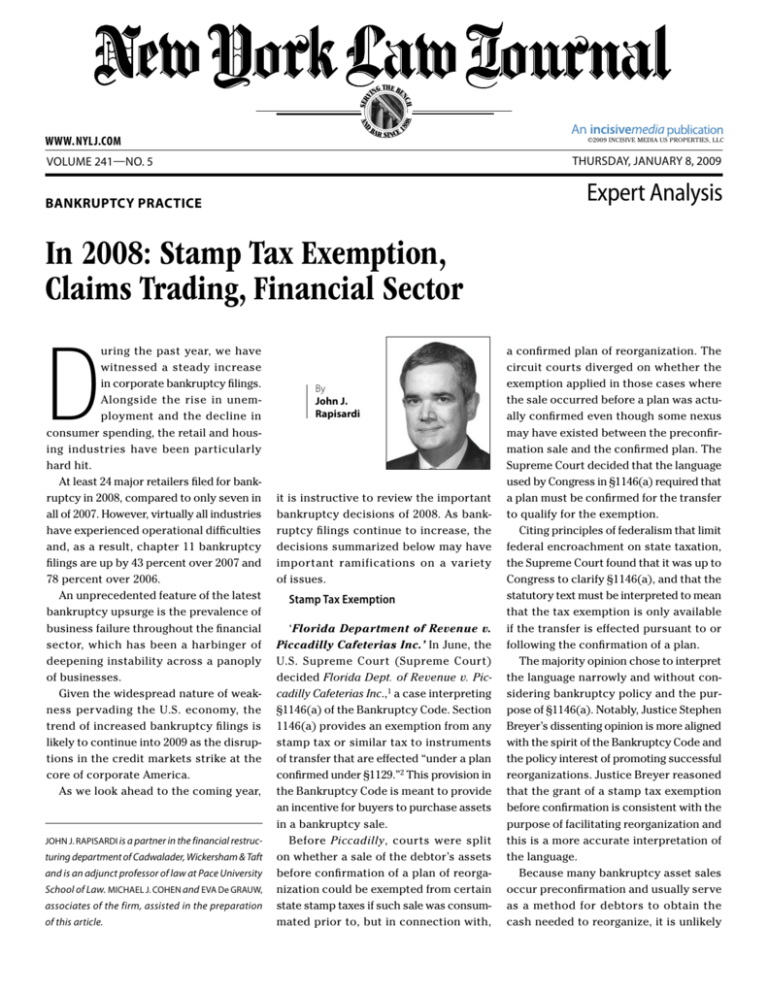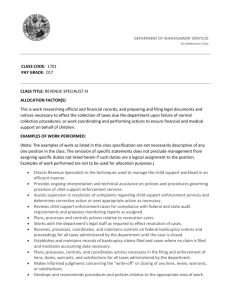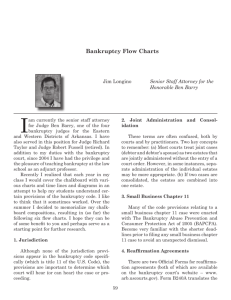
AND
88
8
SER
V
H
NC
THE BE
ING
1
BA
R SINCE
www. NYLJ.com
©2009 Incisive Media US Properties, LLC
thursday, January 8, 2009
Volume 241—NO. 5
Expert Analysis
Bankruptcy Practice
In 2008: Stamp Tax Exemption,
Claims Trading, Financial Sector
D
uring the past year, we have
witnessed a steady increase
in corporate bankruptcy filings.
Alongside the rise in unemployment and the decline in
consumer spending, the retail and housing industries have been particularly
hard hit.
At least 24 major retailers filed for bankruptcy in 2008, compared to only seven in
all of 2007. However, virtually all industries
have experienced operational difficulties
and, as a result, chapter 11 bankruptcy
filings are up by 43 percent over 2007 and
78 percent over 2006.
An unprecedented feature of the latest
bankruptcy upsurge is the prevalence of
business failure throughout the financial
sector, which has been a harbinger of
deepening instability across a panoply
of businesses.
Given the widespread nature of weakness pervading the U.S. economy, the
trend of increased bankruptcy filings is
likely to continue into 2009 as the disruptions in the credit markets strike at the
core of corporate America.
As we look ahead to the coming year,
John J. Rapisardi is a partner in the financial restruc-
turing department of Cadwalader, Wickersham & Taft
and is an adjunct professor of law at Pace University
School of Law. Michael J. Cohen and Eva De Grauw,
associates of the firm, assisted in the preparation
of this article.
By
John J.
Rapisardi
it is instructive to review the important
bankruptcy decisions of 2008. As bankruptcy filings continue to increase, the
decisions summarized below may have
important ramifications on a variety
of issues.
Stamp Tax Exemption
‘Florida Department of Revenue v.
Piccadilly Cafeterias Inc.’ In June, the
U.S. Supreme Court (Supreme Court)
decided Florida Dept. of Revenue v. Piccadilly Cafeterias Inc.,1 a case interpreting
§1146(a) of the Bankruptcy Code. Section
1146(a) provides an exemption from any
stamp tax or similar tax to instruments
of transfer that are effected “under a plan
confirmed under §1129.”2 This provision in
the Bankruptcy Code is meant to provide
an incentive for buyers to purchase assets
in a bankruptcy sale.
Before Piccadilly, courts were split
on whether a sale of the debtor’s assets
before confirmation of a plan of reorganization could be exempted from certain
state stamp taxes if such sale was consummated prior to, but in connection with,
a confirmed plan of reorganization. The
circuit courts diverged on whether the
exemption applied in those cases where
the sale occurred before a plan was actually confirmed even though some nexus
may have existed between the preconfirmation sale and the confirmed plan. The
Supreme Court decided that the language
used by Congress in §1146(a) required that
a plan must be confirmed for the transfer
to qualify for the exemption.
Citing principles of federalism that limit
federal encroachment on state taxation,
the Supreme Court found that it was up to
Congress to clarify §1146(a), and that the
statutory text must be interpreted to mean
that the tax exemption is only available
if the transfer is effected pursuant to or
following the confirmation of a plan.
The majority opinion chose to interpret
the language narrowly and without considering bankruptcy policy and the purpose of §1146(a). Notably, Justice Stephen
Breyer’s dissenting opinion is more aligned
with the spirit of the Bankruptcy Code and
the policy interest of promoting successful
reorganizations. Justice Breyer reasoned
that the grant of a stamp tax exemption
before confirmation is consistent with the
purpose of facilitating reorganization and
this is a more accurate interpretation of
the language.
Because many bankruptcy asset sales
occur preconfirmation and usually serve
as a method for debtors to obtain the
cash needed to reorganize, it is unlikely
thursday, January 8, 2009
Congress intended the benefit of a stamp
tax exemption only for those sales occurring post-confirmation. Piccadilly portends that many asset sales, which often
must occur early in a case to maximize
value, may be chilled by the absence of a
tax exemption.
Lien-Stripping in Asset Sales
‘Clear Channel Outdoor Inc. v. Knupfer (In re PW LLC)’ The U.S. Bankruptcy
Appellate Panel for the Ninth Circuit (Ninth
Circuit BAP) decided Clear Channel Outdoor Inc. v. Knupfer (In re PW LLC)3 last
May. PW involved an asset sale free and
clear of any liens to DB Burbank LLC (DB),
the senior lienholder which was held to
be a good faith purchaser. DB credit bid
the full amount of its lien to purchase
the property. Clear Channel Outdoor Inc.
(Clear Channel) held a junior lien on the
same property and challenged the sale on
the ground that the property could not
be sold free and clear of its lien under
Bankruptcy Code §363(f). Typically, under
§363(m), bankruptcy sales to good faith
purchasers cannot be unwound. However, the Ninth Circuit BAP excluded the
lien-stripping aspect of a bankruptcy
sale from the protection granted under
§363(m) of the Bankruptcy Code, kept
the bankruptcy sale in place, but reinstated a junior lien on the sold property.
Under §363(f), a debtor may sell its
property free and clear of any liens or
interests if (i) applicable nonbankruptcy
law would permit such a sale, (ii) the lienholder consents, (iii) the property is sold
for a value greater than all liens on the
property, (iv) the interest in the property
is in bona fide dispute, or (v) the party
holding the lien or interest could be compelled to accept a money satisfaction of
such interest.4
The Ninth Circuit BAP found there was no
support under §363(f)(3) or (5) to sell the
property free of all liens. No ground existed under §363(f)(3) because it allows a
sale free and clear of all liens when the
purchase price exceeds the value of all
liens on the property. As the credit bid
was only for the value of the senior lien,
this requirement was not met.
The second basis failed as well. Under
§363(f)(5), property may be sold free of its
liens if the lienholder may be compelled
to accept a money satisfaction of his
interest. The Ninth Circuit BAP found the
cram-down provisions under Bankruptcy
Code §1129 did not qualify as a legal or
equitable proceeding and, thus, no basis
existed to compel Clear Channel to accept
a money satisfaction. The ruling in this
case portends the introduction of inefficiencies in the bankruptcy sale process
An unprecedented feature
of the latest bankruptcy
upsurge is the prevalence of business failure
throughout the financial
sector, which has been a
harbinger of deepening
instability across a panoply
of businesses.
as senior creditors have less incentive to
participate and may be more inclined to
commence state foreclosure proceedings
prior to a bankruptcy filing, which in turn
may cause debtors to precipitously file
for bankruptcy.
Whether other courts follow the Ninth
Circuit BAP’s reasoning or move away from
it will be an important development to
watch for in 2009.
Claims Trading
‘In re Kreisler’ The U.S. Court of
Appeals for the Seventh Circuit (Seventh Circuit) upheld a debtor’s right to
buy claims against its own estate in In re
Kreisler,5 a decision entered last October.
Two chapter 7 debtors, whose cases were
being jointly administered, formed a corporation, Garlin Mortgage Corp. (Garlin),
which then hired Barry Kreisler, one of
the debtors, to negotiate the purchase
of a secured creditor’s claim against the
two estates. In return for negotiating the
purchase of a $900,000 claim for $16,500,
Garlin agreed to pay Mr. Kreisler $35,000
when the claim was paid. Upon learning
of the transaction, the bankruptcy court
equitably subordinated the claim and the
district court affirmed on the ground that
a debtor should not be compensated from
the estates when there were insufficient
funds to pay unsecured creditors.
The Seventh Circuit reversed the decision, finding that the doctrine of equitable
subordination was improperly applied to
this situation. The debtors were entitled
to participate in claim trading, even if the
claims were against their own estates, so
long as the conduct did not disadvantage
other creditors.
Although the transaction at issue may
have included some misconduct by the
debtors, the Seventh Circuit found no
disadvantage to any creditor. The fact
that Mr. Kreisler stood to gain much of
the profit obtained from the transaction
through Garlin’s payment to him did not
disadvantage any creditors. As nothing in
the Seventh Circuit’s reasoning is intrinsic
to a chapter 7 case, similar reasoning will
likely apply in chapter 11.
Though this decision may seem troubling to potential unsecured creditors,
the payment to which a debtor such as
Mr. Kriesler would be entitled to receive
would otherwise go to the original secured
creditor, which would leave the unsecured
creditors’ position unchanged regardless
of the recipient of the payment on the
secured claim.
Executory Contracts:
• Rejection or Assumption.
‘Giant Eagle Inc. v. Phar-Mor Inc.’ The
Sixth Circuit decided Giant Eagle Inc. v.
Phar-Mor Inc.6 in May. Pursuant to §365
of the Bankruptcy Code, the debtor, PharMor Inc., rejected an equipment lease it
had with Giant Eagle Inc. Giant Eagle then
mitigated its damages by re-leasing the
equipment to a subsequent lessee. The
thursday, January 8, 2009
subsequent lessee later filed for bankruptcy protection and rejected its lease.
Giant Eagle then sought claims in PharMor’s case for liquidated damages in lieu
of prospective monthly lease payments (as
permitted under the terms of the lease)
less the amount mitigated. The bankruptcy
court sustained Phar-Mor’s objection to
such claim. The Sixth Circuit overturned
this ruling, holding that Giant Eagle’s claim
could be revived after a subsequent lessee rejected a lease during the previous
lessee’s remaining lease term.
Phar-Mor’s argument was that Giant
Eagle’s execution of a new lease mitigated all future damages claims Giant Eagle
may have had against it. However, the
Sixth Circuit found that a party may seek
damages at the time it asserts its claim
in a bankruptcy proceeding, even if such
assertion comes after a subsequent lease
is executed and then rejected. The Sixth
Circuit found that the amounts paid by the
subsequent lessee could decrease what
Phar-Mor owed, but the execution of the
subsequent lease did not extinguish PharMor’s obligations.
When, as here, a subsequent lessee
rejects a lease prior to the settlement
of the lessor’s claims against the prior
debtor-lessee, a claim may be revived.
The Sixth Circuit essentially eliminated
any downside risk of mitigating damages.
However, this decision does raise additional issues that may need to be resolved
in future cases, such as whether the claims
against an initial lessee should be adjusted
if the lessor succeeds on additional claims
against the subsequent lessee.
‘COR Route 5 Co., LLC v. The Penn
Traffic Co. (In re Penn Traffic Co.)’ In
April, the Second Circuit decided In re
Penn Traffic Co.7 which involved a dispute
between COR Route 5 Co. LLC (COR) and
the debtor, The Penn Traffic Co. over an
agreement that obligated both parties
to make certain transfers of property
and money.
At the time of Penn Traffic’s bankruptcy
filing, major obligations under the COR-
Penn Traffic agreement remained unperformed. Several months later, Penn Traffic declined COR’s attempt to tender its
performance, and then rejected the agreement. COR brought a claim on the ground
that the agreement was not executory and
thus could not be rejected by Penn Traffic under §365 of the Bankruptcy Code.
The bankruptcy court and district court
disagreed, and COR appealed the decision
to the Second Circuit.
The Second Circuit agreed with the lower
courts and affirmed that Penn Traffic could
reject the contract because it remained
executory. The Second Circuit held that a
contract becomes nonexecutory when it
expires post-petition or when the debtor
takes affirmative action that affects the
obligations under the contract. Neither
of these situations existed in Penn Traffic.
The court reasoned that allowing COR to
alter the “executoriness” of a contract by
tendering post-petition performance would
interfere with the debtor’s right under §365
to evaluate its executory contracts and
determine which ones should be rejected
in order to alleviate the burdens on its
estate. Existing Second Circuit precedent
makes it clear that a debtor’s right to elect
which contracts to reject or assume lies
only with such debtor, and a nondebtor
party cannot interfere with such right.
Penn Traffic reinforces a critical debtor
right. If a nondebtor party were given the
option to tender performance post-petition
and thereby make a previously executory
contract nonexecutory, a debtor could
become saddled with contracts it might
otherwise have rejected. More importantly,
such an action could detrimentally interfere with a debtor’s ability to reorganize.
The Second Circuit appropriately affirmed
the lower court’s decision to ensure
that debtors retain exclusive control
over decisions to reject or assume their
executory contracts.
Conclusion
Interestingly, the U.S. Supreme Court
has not accepted any bankruptcy issues
for resolution during the current term.
However, in 2009 the bankruptcy bar will
be quite immersed in a multitude of major
filings, featuring an array of complexity, magnitude and breadth that may be
unmatched by any year in recent history.
With this interesting mix of new cases,
many issues of significance are bound
to arise.
•••••••••••••
••••••••••••••••
1. 128 S.Ct. 2326 (2008).
2. 11 U.S.C. §1146(a).
3. 391 B.R. 25 (9th Cir. B.A.P. 2008).
4. 11 U.S.C. §363(f).
5. No. 06-3881, 2008 WL 4613880 (7th Cir. Oct. 20,
2008).
6. 528 F.3d 455 (6th Cir. 2008).
7. 524 F.3d 373 (2d Cir. 2008).
Reprinted with permission from the January 8, 2009 edition
of the NEW YORK LAW JOURNAL© 2009 Incisive US
Properties, LLC. All rights reserved. Further duplication
without permission is prohibited. For information, contact
877-257-3382 or reprintscustomerservice@incisivemedia.
com. # 070-01-09-12








